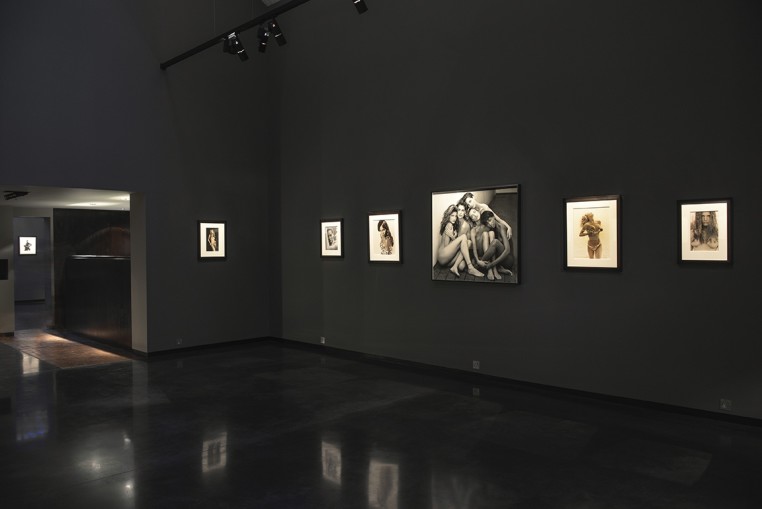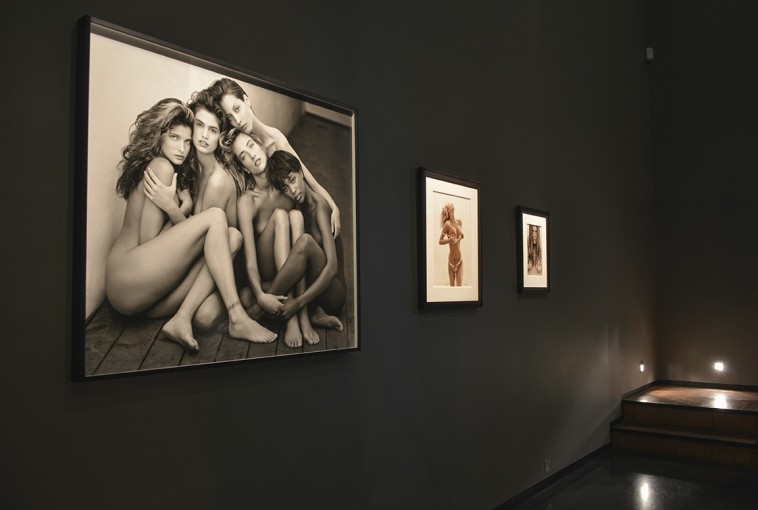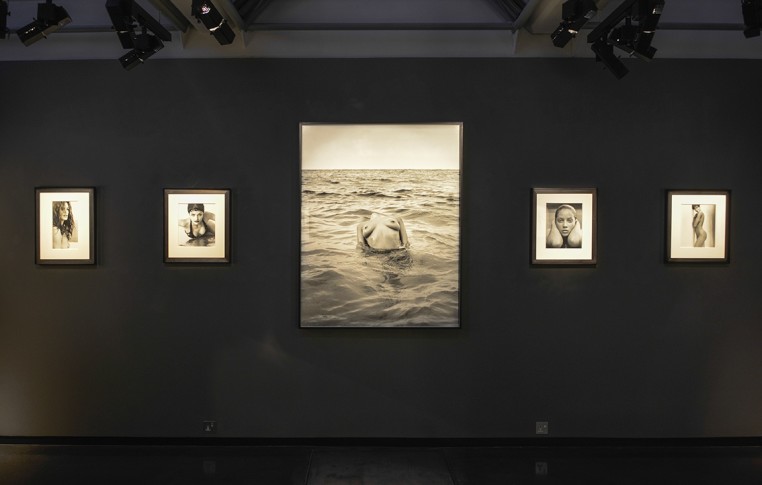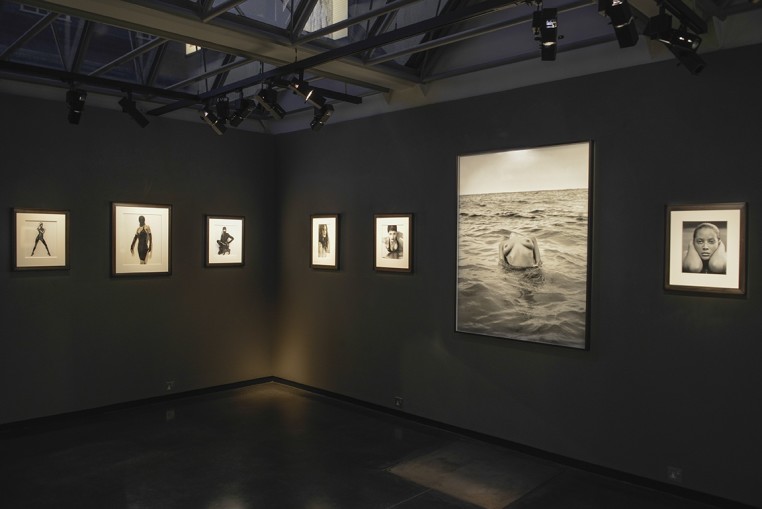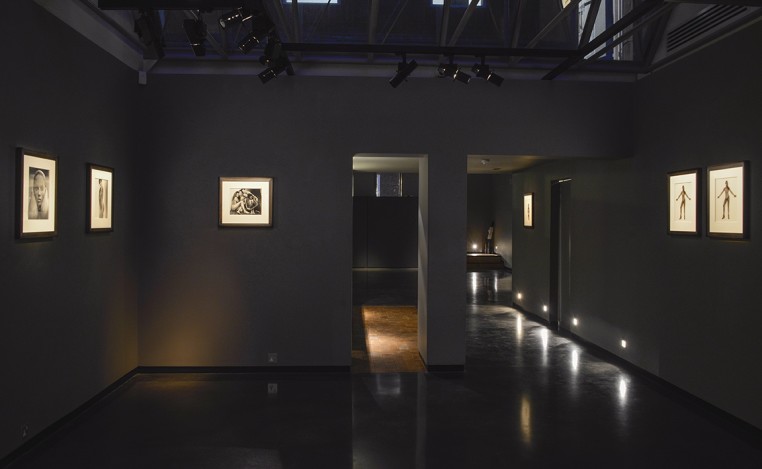Hamiltons is the sole representative for world-renowned American photographer Herb Ritts in the UK. These two exhibitions, 'Herb Ritts: Super' (25th November 2016 - 28th January 2017) and 'Herb Ritts: Super Part II' (30th January - 10th March 2017) celebrated the enduring legacy of Ritts’s photography and the gallery’s longstanding relationship with the Herb Ritts Foundation, with a selection of rare vintage gelatin silver prints of supermodels from the Foundation’s archive. Following the popularity of ‘Herb Ritts: Super’, Hamiltons showcased another selection of Ritts' supermodel prints in 'Herb Ritts: Super Part II'.
Ritts was largely self-taught with no formal training in photography, yet by the late 1980s he had become a celebrity, just like the people he photographed, “a testament to his natural talents and likeability... Some people are born visually sophisticated – they don’t have to be taught composition.” (David Fahey) Ritts played an important role in ushering the era of the supermodel, “he made the models ‘super’”, and he captured images of some of the most noted individuals in film, fashion, music, politics and society. Ritts’s big break came in 1979 with portraits of the budding actor Richard Gere, which were published by Vogue, Esquire and Mademoiselle all in the same month.
Ritts’s lack of formal training is partially the reason his style became so distinctive. Ritts, unlike many of the studio based photographers of the time, preferred to work outdoors and had very simple equipment requirements, often working without a tripod. The “anti-glamour” photographer, Ritts photographed his supermodels outside to make use of the natural afternoon Los Angeles light, often at the beach or in the desert. As Naomi Campbell said: “You just fall in love with that light – it’s Herb’s light”. Ritts was drawn to elemental places, where he could use the sea, sand and sky as backgrounds, and so his hometown of Los Angeles would become inextricably linked to his success, due both to the people living there and its outdoorsy lifestyle. “Herb lived that light, he grew up with that light, with that sun, with that water, with those elements, with the sand…” (Steven Meisel)
“Herb didn’t love when fashion got super complicated; it definitely was not his thing. So in those kind of situations he would use lighting and movement.” (Christy Turlington)
Natural light, shadows, shape, movement and texture permeate Ritts’s work. As is evident in the photographs in this exhibition, often unencumbered by studio walls and technicalities, Ritts was able to “give a truthful interpretation behind the surface and into the soul of the sitter”. Ritts never envisaged the final shot, preferring to find a rhythm together with his sitter as they worked; a method which created an opportunity for spontaneity and magic to happen between Ritts and his models. These photographs can be seen as a natural collaboration between photographer and subject, moving together to create the finished effect and allowing the model’s personality to come through. It is not surprising therefore that Ritts became such close friends with those he photographed. Referring to the pictures in this exhibition of herself on the beach for Playboy magazine, Stephanie Seymour said: “On the beach, Herb was incredible… the shoot that really stands out was the Playboy shoot. I almost didn’t go… I was nervous… but we had the best time, and the pictures were so incredible. Half the time when we worked with Herb, we wouldn’t even want to stop. Because once you get that rhythm going, you just don’t want to stop. You don’t want to break it.”
“The way Herb photographed you was the way you wanted the world to see you. Herb saw the best in everyone, so that’s how he photographed you… For a model it’s very unsatisfying to come in when the photographer’s already worked out the photo: Where’s me in this picture? I never felt like that with Herb. You definitely felt like you made a contribution.” (Cindy Crawford)
Soon after his success in 1979, Ritts began to collect photographs himself, helping to develop his connoisseurship skills, honing his eye to recognise well balanced composition and good quality prints. “Edward Weston’s sleek modernist forms, Man Ray’s experimental photographs… and the suggestive sensuality in Horst P. Horst’s nudes… Herb’s photographs… were inspired by a subtle blending of the best qualities of the photographers he admired. But Herb’s work, made from his own vision, was undeniably unique and authentic.” (David Fahey) Ritts was also influenced by and knowledgeable about Classical style, his slick black and white portraits often reminiscent of Greek sculpture. He reveled in and celebrated the beauty of the human body, thus often photographing athletes or dancers and challenging conventional notions of gender, race and sexuality. He was drawn to clean lines and strong forms, a graphic simplicity which allowed his images to be read and felt instantaneously. “Herb derived a style that delivered the perfect irony: the planned and posed images showing the subjects’ reality.” (David Fahey) The balance and order of his photographs were only enriched further by the contrasting element of mystery and spontaneity.
“I say this kindly, but I don’t see that many up-and-coming photographers with the same finesse, that understand the light so well, that understand film, that also understand how to communicate. But Herb was always so excited… You feel like you’re actually creating things together, and the great photographers all have that… And it was magical. That’s the best way I can describe Herb, it is always magical.” (Tatjana Patitz)
Herb Ritts, born in Los Angeles in 1952, began his photographic career in the late 1970s, quickly gaining a reputation as a master of art and commercial photography, becoming one of the first photographers to bridge the gap between art and commerce. After shooting to fame in 1979 with his photographs of Richard Gere, Ritts went on to produce portraits and editorial fashion for Vogue, Vanity Fair, Rolling Stone and Playboy and created advertising campaigns for Chanel, Calvin Klein, Gianni Versace, Giorgio Armani, Levi’s, Pirelli, Polo Ralph Lauren and Valentino, amongst others. From 1988 he directed numerous influential and award winning music videos and commercials. Ritts’s fine art photography has been the subject of exhibitions across the globe including The J. Paul Getty Museum, Los Angeles in 2012, Museum of Fine Arts, Boston in 2015 and most recently Maison Européene del la Photographie, Paris in 2016, and much of his work resides in significant public and private collections worldwide. Ritts was committed to HIV/AIDS related causes, contributing to many charities such as Elizabeth Taylor AIDS Foundation and he was a charter member on the Board of Directors for the Elton John Aids Foundation. Herb Ritts died on December 26th 2002. Prior to his death, Ritts communicated his desire to create a foundation that would carry on his passion for photography and charitable support for HIV/AIDS, thus in 2003 the Herb Ritts Foundation was established. “Herb made truly unforgettable photographs. He gave us a visual record of his time and place and a portrait of an era. The sand, sea, shadows, and sky were his backdrops. Perfectly sculpted light, elegant strength and an enduring beauty are the defining characteristics of his work.” (David Fahey)
“He had a genius for lighting, he had a genius for shape, and when you get all that into something it makes Herb Ritts a very special person, and as a photographer one of the best of all time.”

